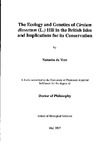The Ecology and Genetics of Cirsium dissectum (L.) Hill in the British Isles and Implications for its Conservation
| dc.contributor.author | de Vere, Natasha | |
| dc.contributor.other | School of Biological and Marine Sciences | en_US |
| dc.date.accessioned | 2013-11-05T11:01:59Z | |
| dc.date.available | 2013-11-05T11:01:59Z | |
| dc.date.issued | 2007 | |
| dc.identifier | NOT AVAILABLE | en_US |
| dc.identifier.uri | http://hdl.handle.net/10026.1/2590 | |
| dc.description.abstract |
The aim of this study was to research the ecology and genetics of Cirsium dissectum and to discuss the implications of the results for its conservation. The ecology of C. dissectum was described through a review of the literature. Site characteristics, plant communities and reproductive biology were investigated by examining 22 populations throughout the British Isles. Microsatellite genetic markers were used to investigate levels of genetic diversity within and between these populations. Within populations, relationships between genetic diversity, population size, fitness and habitat quality (concentrating on soil nutrients and vegetation structure) were explored using multiple regression and structural equation modelling. Differentiation between populations was examined by comparing rnicrosatellite markers with morphological traits and this was supplemented by a crossing experiment that investigated the effects of inbreeding and outbreeding. This study showed that C. dissectum was a clonal species with a mixed mating system. Previous research had suggested that clonal propagation was the dominant form of reproduction but this study showed that sexual reproduction was important in this species, as levels of genotypic diversity were high. There were interactions between population size, genetic diversity, plant fitness and habitat quality. Smaller populations of C. dissectum had lower genetic diversity and this subsequently reduced plant fitness. Higher levels of bare soil and phosphorus were related to higher levels of genetic diversity; bare soil may provide establishment gaps for seedlings and clonal offspring, while phosphorus may encourage flowering and/or seedling survival. Populations of C. dissectum showed high levels of genetic differentiation and strong isolation by distance using microsatellite genetic markers. Both microsatellite genetic markers and morphological traits revealed geographical structuring between populations, but this was less pronounced using the morphological traits. Plants in Ireland showed higher levels of morphological differentiation compared to Britain. C. dissectum showed strong, early acting inbreeding depression when plants were selfed and a trend towards outbreeding depression when genetically distant populations were crossed. Populations of C. dissectum should be conserved throughout the geographical range of the species in the British Isles. Sites should be managed so that habitat heterogeneity is maintained, enabling C. dissectum rosettes to flower and to maintain bare soil for seedling establishment. Habitat restoration should use seed collected from a number of local populations of the same habitat. | en_US |
| dc.language.iso | en | en_US |
| dc.publisher | University of Plymouth | en_US |
| dc.title | The Ecology and Genetics of Cirsium dissectum (L.) Hill in the British Isles and Implications for its Conservation | en_US |
| dc.type | Thesis | |
| plymouth.version | Full version: final and full version as approved by the examiners at the time of the award of your degree | en_US |
| dc.identifier.doi | http://dx.doi.org/10.24382/3818 | |
| dc.identifier.doi | http://dx.doi.org/10.24382/3818 |
Files in this item
This item appears in the following Collection(s)
-
01 Research Theses Main Collection
Research Theses Main


